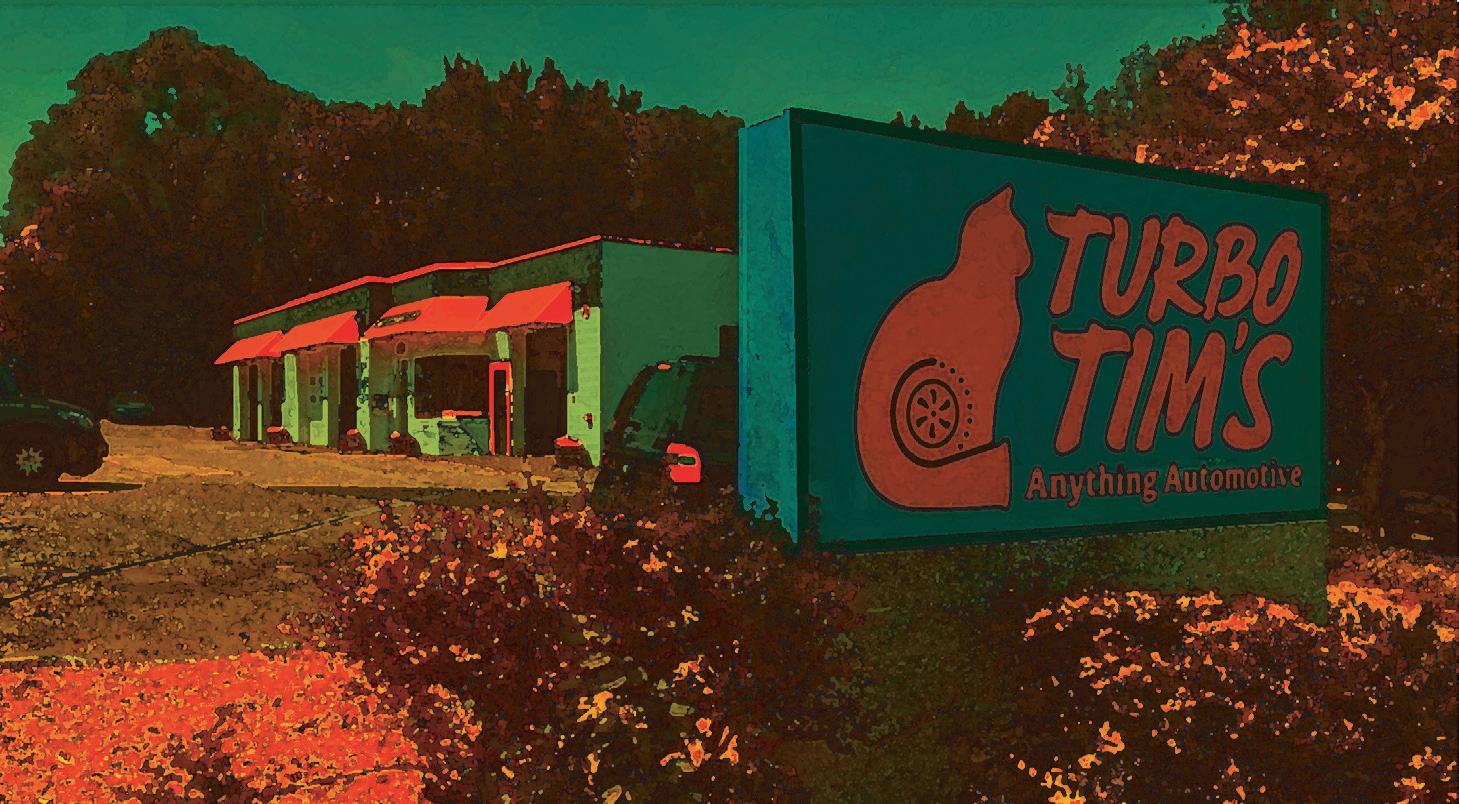



















Patti Powell, Financial Advisor connect.thrivent.com/new-hope-group









Volume 30, Issue 767 • October 17-30, 2024
Managing Editor Noah Mitchell 612-461-8723
Editorial Assistant Linda Raines 612-436-4660
Editor Emeritus Ethan Boatner
Contributors Layla Amar, Lakey Bridge, E.B. Boatner, Buer Carlie, Natasha DeLion, Arthur Diggins, Alyssa Homeier, Terrance Griep, Elise Maren, Jen Peeples-Hampton, Linda Raines, Alexander Reed, Gregg Shapiro, Randy Stern, Susan Swavely, Carla Waldemar, Todd P. Walker, Emma Walytka, Spencer White
Vice President of Sales & Advertising
Barry Leavitt 612-436-4690
Account Executives
Nathan Johnson 612-436-4695
Richard Kranz 612-436-4675
Sales & Event Administration
Linda Raines 612-436-4660
National Sales Representatives
Rivendell Media 212-242-6863
Creative/Digital Director Mike Hnida 612-436-4679
Publisher Lavender Media, Inc.
President & CEO Stephen Rocheford 612-436-4665
Chief Financial Officer Doug Starkebaum 612-436-4664
Administrative Assistant Michael Winikoff 612-436-4660
Distribution Metro Periodical Partners 612-281-3249
Founders George Holdgrafer, Stephen Rocheford
Inspiration Steven W. Anderson (1954-1994), Timothy J. Lee (1968-2002), Russell Berg (1957-2005), Kathryn Rocheford (1914-2006), Jonathan Halverson (1974-2010), Adam Houghtaling (1984-2012), Walker Pearce (1946-2013), Tim Campbell (1939-2015), John Townsend (1959-2019), George Holdgrafer (1951-2024)
Editor, 5100 Eden Ave, Suite 107, Edina, MN 55436 or e-mail editor@lavendermagazine.com.
For our Privacy Policy, go to LavenderMagazine.com/resources/ privacy-policy
LAVENDER MEDIA, INC.
5100 Eden Ave, Suite 107, Edina, MN 55436
612-436-4660 Office 612-436-4660 Subscriptions/Distribution
612-436-4660 Lavender Advertising











OUR
BY NOAH MITCHELL
Over the past couple of years, I’ve made a concerted effort to improve my cooking. When I have the time, I cook my own meals from (mostly) whole ingredients. While I’m not yet making (or even attempting) perfect soufflés, I’m no longer reliant on frozen and processed foods, and I’m confident that I can cook meals that I can proudly share with friends and family. Throughout this process, I’ve learned a lot — how to properly use different utensils and prepare different foods, what flavors combine well and why, and even a little bit about the chemistry of food. I’ve used online resources and received advice and assistance from friends and family. I’ve upgraded some of my tools and

utensils. Overall, it’s been a challenging and rewarding process.
And, after all that, I still can’t make anything that could be confused for restaurant quality. Granted, some of that has to do with my relative level of effort and my starting point. While I’ve learned a lot, I started with very little knowledge and I certainly haven’t prioritized cooking to a level that would make a superior end product more likely.
However, my main takeaway is this: chefs and restaurant staff are just really good at their jobs. Restaurants are a relatively modern phenomenon in terms of human history as a whole, and I think we’re incredibly lucky to exist at the
OUR LAVENDER | A WORD IN EDGEWISE
BY E.B. BOATNER
same time as establishments dedicated to providing us with delicious meals.
Not only do we have restaurants, but here in the Twin Cities, we have good ones. Whether you’re looking for tapas or small plates paired with wines, pizza and pasta from family a family kitchen or the best pie in the country, they’re all here, and that’s just in this issue of Lavender.
As I read the stories in this issue and remembered a particularly poor pasta of mine, I became more excited than ever for my next dinner out. The only problem is having to pick one restaurant out of the many great options in town — but I have a few ideas on where to start!
1844: A Bavarian man stands alone on a New York pier. Newly arrived in America, he has only a suitcase, not even an identity until an impatient immigration official haggles his alien “Heyum” into American “Henry” and pares a final “n” off Lehmann. The man, Henry Lehman, now has a name, a suitcase — and dreams.
It can’t have been easy, being just one among a myriad of other Jewish immigrants jostling on the crowded docks on the fringe of a teeming city. Of course, on this stage, nothing actually teems — only Henry, joined later by brothers Emanuel, and Meyer, the first American Lehmans, will appear. The three become all: wives, offspring, Alabama plantation owner, investor, the cacophony of voices flowing through the next 164 years. But now, New York is cold, crowded, indifferent. Henry moves to Montgomery, Ala., closer to cotton.
In their little shop, selling a broad array of fabrics — “by the yard or inch, even dineem!”— profit is scant. Manuel and Meyer arrive. What if … what if we just bought raw cotton, and sold in bulk to the northern mills? And they did, brokering entire crops from scores of plantations, until…
War. Dark and bloody ground replaced the white gold of cotton; blockades restricted moving any that remained. Emanuel moved up to New York, the center of the action and the money. Meyer joins him; they found the New York Cotton Exchange, then realize, “Railroads are the coming thing!” The Lehmans transition
to investment banking, suavely offering, “If you, Mr. Railway Man, guarantee us nine million dollars, we will see you get the funding you need. All kinds of product will roll and we both will profit. And Railway Man agreed, no, he believed— and it was done, and the money rolled.
Nearing the end of the century, Lehman Brothers joins the New York Stock Exchange. Family evolves, Henry dies (of yellow fever) at 33, Meyer at 67, and Emanuel at 79. All three missed the horror of 1929’s Black Thursday. But Lehman Brothers — the entity — scraped along.
One of Meyer’s three sons, Herbert Henry, left the business at 50 for “politics” (mentioned sarcastically by kin). He served in his own fashion, as a New York senator and four-times governor (D) of that state from 1933 to 1942, receiving in 1961 a Freedom Award from President Lyndon B. Johnson, while Lehman Brothers, always looking to mine the future, were investing in the Digital Equipment Corporation.
How was it then, after pulling through the Crash of ’29, that on September 15, 2008, Lehman Brothers declared bankruptcy, and America tipped into the Great Recession? What’s the lesson here? Henry came with nothing, then he, Emanuel and Meyer created something. Something big, wealth, yes. But they invented the middleman, the broker, and turned skepticism into belief, belief into money.
Nature proliferates beyond “enough,” but is there any limit to just “how much” can pair sustainably with “sufficiency”? Perhaps one limit on
humans is their brief hold on mortality. And their insistence on individuality.
The world’s largest tree is a quaking aspen clone named “Pando” (Latin for “I spread”) whose some 40,000 stems now blanket 106 acres in Fishlake National Forest in central Utah, calculated to have sprung from a seed germinated at the end of the last Ice Age. Termites too, are no slouches at acquisition and proliferation: One African mound’s sixty-foot dome provided airconditioning for 200 miles of tunnels, while a recent termite megalopolis discovered in Brazil revealed some million mounds dating back 4,000 years.
Is continued acquisition natural? Or a human failing? Aspen and termite alike were created for their single task, the individuals living, dying throughout time. There’s no maverick, lemonbearing aspen, no termite Falling Water terraced cone. For the brothers Lehman, only three, aiming for the same goal, perceived the prize through different lenses. And a lesson learned in human time may not suit the next crisis in a human society. Are we witnessing good guys and villains here or individuals doing their best with a world in flux?
Don’t miss this one. Edward Gero (Henry), William Sturdivant (Emanuel) and Mark Nelson (Meyer) offer a stunning array of characters along the Lehmans’ measuring cloth in feet and inches to 2008’s dancing on the brink — and on the Guthrie’s Wurtele Thrust Stage through October 13.








































































































“Drawing Lessons” is the Children’s Theatre Company’s latest show, which will run from October through November of this year. The show is aimed at older children and teenagers, and is a highly visual experience that will appeal to anyone who loves comics and graphic novels. The story centers on Kate, a young artist and Korean American who is trying to figure out her place at school, in her family and as a creative. The role of Kate is shared by two young actors (Olivia Lampert and Mars Niemi) who trade off the role from night to night. I had the chance to speak with Niemi about their thoughts on the show and their experience playing Kate and being a part of “Drawing Lessons.”
“I identify as trans-masc, genderfluid, and gender-ambiguous and go by he/they pronouns,” says Niemi, “I am playing a character whose gender is different than mine, and I want that to be known.” Although Kate uses she/her pronouns and Niemi uses he/they, Niemi has speculated that he and Kate might be more alike than a surface-level reading suggests.
“As Kate’s gender identity is never explicitly talked about, I headcanon that she may be figuring out some things related to her gender, so there is some ambiguity and fluidity regarding this in my portrayal of Kate,” Niemi explains. “She was also raised without a mother figure, so her mannerisms are subconsciously more masculine and similar to her dad’s.”
Niemi continues, explaining how they have found other parts of themselves in Kate: “[I] connect a lot with Kate. I was also often distracted in class and had a difficult relationship with my father which is similar to Kate as well.”
Clearly, Niemi has brought a lot of himself to creating Kate, but he would be the first to tell you that Kate has taught him a few things as well. “Developing the role of Kate has taught me that silence is not a sign of weakness and that being strong-willed is a strength as long as you don’t let it get to your head,” they say. “I’ve always been strongwilled, determined, and experienced being the quiet kid throughout middle school.”
“Drawing Lessons” is aimed at an older audience. Although young children will likely enjoy the visual elements of the show, the brunt of the story deals with issues like selfexpression, alienation and race that will be more resonant to an audience of upper elementary through high school students.
“I hope for audiences to take with them an understanding of those who are quiet or shy and can’t speak up,” says Niemi. “I would also like them to take with them the lesson that perseverance and commitment to your art is rewarding and that you should pursue your dreams and become an artist. I hope for audiences to connect with Kate throughout this raw and intimate yet beautiful story. Especially during the hardest times.”
When Niemi is not playing Kate, that responsibility falls to Lampert. “I’ve had such a fantastic time sharing this role with Olivia,” he says. “She is so talented and I admire her work as an artist. We have very different takes and ways of portraying Kate, so depending on who’s performing as Kate, the show is completely different. So, if you are able, I would recommend coming twice to see both of us perform.”

“Drawing Lessons” is a coming-of-age story that will appeal to many children who are also working to figure out their place in the world. “I want to share this beautiful story about how and why a sensitive young person might start to identify as an artist with the incredible audience community that CTC has cultivated in the Twin Cities,” says director Jack Tamburri. “Drawing Lessons” marks yet another World Premiere Production at the Children’s Theatre Company through Generation Now, which is a powerhouse partnership between five theaters and has the express intent of creating new, diverse works for multigenerational audiences. “Drawing Lessons” was co-commissioned by the Children’s Theater Company and Ma-Yi Theater Company in New York.
“‘Drawing Lessons’ shows CTC at its best,” says CTC Artistic Director Rick Dildine. “CTC has a history of creating new work, and this original piece incorporates the craft of the comic artist into the theatrical process in a dynamic way.”
Playwright Michi Barall is also excited about bringing visual art into the storytelling on stage: “Comic artist Blue Delliquanti’s drawings are full of movement, warmth and humor, beautifully illustrating Kate’s inner and external worlds. I know that experiencing Blue’s visual storytelling on a theatrical scale will be magical!”
Bringing “Drawing Lessons” to the stage has been exciting for Barall. “It’s absolutely thrilling to see my initial rendering of ‘Drawing Lessons’ become a multi-dimensional production,” Barall says. “I am so immensely grateful to have such innovative and wildly imaginative creative partners on the design team.”
“Drawing Lessons” runs from October 8 through November 10 of this year on the Cargill Stage at CTC, with opening night falling on Saturday, October 12, 2024, at 7 p.m. The show has a 90-minute runtime with one 20-minute intermission.
Tickets start at $15 and can be purchased online at childrenstheatre. org/drawing or by calling the Ticket Office at (612) 874-0400.

BY GREGG SHAPIRO

Released earlier this year, the album “Blue Raspberry” (Anti-) by out singer/songwriter Katy Kirby deserves a place near the top of my best of 2024 list. Texas native Kirby, now based in Brooklyn, is a distinctive young songwriter, and she performs her songs with a confidence that belies her age. “Blue Raspberry” has been on repeated spins since it arrived, and I’ve been enthusiastically recommending songs including “Drop Dead,” “Table,” “Cubic Zirconia,” “Fences” and “Redemption Arc” to friends and family, for their artistry and irresistible sound. Kirby even received some love from SiriusXM’s channel 35 (XMU), where “Hand to Hand” remains in heavy rotation. Katy was kind enough to make time for an interview to discuss “Blue Raspberry.”
Gregg Shapiro: In the “Thank Yous” for “Blue Raspberry,” you mention “the archives of Arthur Russell at the New York Public Library for the Performing Arts.” Please say a few words about the influence of the late gay songwriter Russell on your work.
Katy Kirby: I have been a fan of his songwriting for years. I found out through a friend of a friend that the New York Public Library had received his archives recently and had started opening them to the public. My guitar player and producer Logan [Chung] did the bureaucratic research to figure out how to get in there. Those librarians were so helpful. They were like, “Yeah, touch all these pieces of paper with your hands.” They have some of Arthur Russell’s pencils! They want people to see it. It was so exciting. We got to hear a bunch of demo tapes and stuff from sessions. If I’m just basing it off his scribbled notes, he was just as wacky of a guy as one might think. It made me feel very seen.
GS: He had such a broad spectrum of musical talent. There’s his electronic and dance music stuff, but then there’s all this stuff that’s folky and country-influenced.
KK: He had such range, and I love the type of folk music that he was doing. It was so fascinating and it’s good.
GS: Are there other musical influences and inspirations you’d like to mention?
KK: I like the way that Angel Olsen records always sound pretty sweeping, even when they’re quiet. We’ve been listening to a lot of Sam Cooke recently before we started to make the record. And songs that were very obviously love songs from that era.
GS: Regarding your songwriting process, the songs “Cubic Zirconia,” “Part of the Century” and “Table,” were co-written by you and members of your band who perform them with you on the “Blue Raspberry” album. Are these compositions the kind that were created in the studio or were they written beforehand?

KK: It’s kind of both. My band is such a part of how the songs end up sounding that it seemed only reasonable to credit them with writing some of them. I believe I wrote all the lyrics myself. For some of those that were written later, I realized that sometimes I don’t feel like I’m done with a song until I bring it to Logan and Alberto [Sewald] and Austin [Hoke] and Lane [Rodges]. It depends, but they are such an enormous part of the process of what those songs turn into, that it’s certainly not just me.
GS: Your Anti- label-mate Christian Lee Hutson, who has worked with Phoebe Bridgers, is also credited as a co-writer on “Part of the Century.” How did you come to collaborate with him?
KK: We became friends on the Internet and then we hung out in real life. We wrote that (song) over FaceTime just for fun a couple of years ago, I guess. We threw a bunch of things at the wall and then weren’t really sure if we had made anything good or not. Then I whittled it down a little bit, and as it turned out there was kind of a little bit of a story in that song. So, that was nice.
GS: I picked up on some recurring themes in the songs. For example, cubic zirconia in the song of the same name, as well as “Alexandria” and “Salt Crystal,” salt crystal in the song of the same name and the title track and “Fences” in the song of the same name, as well as “Wait Listen.” Please say something about the use of this wordplay and repetition.
KK: The way that those songs were coming to me at the time, they all felt connected, or they were part of sort of the same thought. Some of those images were interesting enough to me that I wanted to use them twice. Once I did, I liked how it put the songs in dialogue with each other. I would like that if another songwriter did that. I think Ezra Koenig of Vampire Weekend has a couple of songs where he says, “I don’t want to live like this, but I don’t want to die.” I always thought was super fun to think about. I liked it as a listener, so I thought I would try to get away with it myself, I guess.
GS: I think you succeeded.
KK: Okay, I’m glad!
GS: I know from your bio that you come from an evangelical Christian background, which made me think of queer singer/songwriter Becca Mancari who had a similar upbringing. I’m also aware that there are other queer performers who had a related experience. How did your family react to your coming out?
KK: It was interesting. I really didn’t have a coming out experience per se with them. I was 26 when I started dating a girl for the first time. It was someone that they had known for a while. She was someone I went to college with. I didn’t really feel like I made an announcement. We just started seeing
each other. Then I told my mom, I told my dad, and I told my siblings. They were all like, “Okay!” I don’t know if I ever said it out loud, like “I’m gay.” I just said, “I’m dating.”
GS: You’re very lucky.
KK: I am so absurdly lucky that I almost don’t feel entitled to say that I came out. It barely counts because they were just … my parents were like standard evangelicals at some point, and they didn’t love gay stuff. But they never said anything cruel or were super-intense about that. Especially now, they’ve mellowed into their older age. There was literally zero drama or clutching of pearls attached to any of it. It was pretty good. I got off so easy.
GS: Anti- Records has a long history of queer acts on its roster including The Drums, Bob Mould, and Ezra Furman. How does it feel to be in such company?
KK: Honestly, being on Anti- Records was at the top of my internal bucket list of goals. It felt really weird after signing with them because I didn’t think I would achieve that goal as early in my career. I had no other goal to work towards. I felt adrift because I really have loved that label so much and respected how they’ve been. I was completely unmoored by signing with them. It was great.

GS: Earlier this year, at the Grammy Awards, queer women, including boygenius, Miley Cyrus, Tracy Chapman, Victoria Monét, Billie Eilish, Janelle Monáe and Brandy Clark, to name a few, were represented among the winners, and nominees. As an out artist, what does that kind of representation mean to you?
KK: The thing that I thought about the Grammys the most recently is how precious it is. There are these pictures of boygenius with their Grammys that I saw, and Julien Baker obviously has just been weeping. Not like celebrity, “I won a Grammy” happy weeping, but she looks like she’s actively crying. It’s so cute! It makes me feel a little more confident that the songs on “Blue Raspberry” can enter the category of love songs without necessarily having the queer label indelibly attached to it. I think it’s important that they’re queer love songs, but also, they get to expand a little bit out of that world as well. It’s not such a niche category.
GS: Love is love. It’s a universal language, and all that kind of stuff.
KK: Right, it’s not like it’s exotic or some weird angle. They’re just love songs.
GS: What are you most looking forward to about the concert tour on which you are embarking?
KK: I’ve really been enjoying playing some of the songs on this record that I was scared to perform live, like “Redemption Arc” or “Hand to Hand,” or some of the slower, weirder ones. Those have been challenging, but fun. A couple of people have been singing along to those in some of those crowds, which is shocking, but nice.
Editor’s note: Katy Kirby is performing November 16 at the Fitzgerald Theater in St. Paul.

BY CARLA WALDEMAR

Wait, wait: Don’t run for the air raid shelter. Trot, instead, to the North Loop to discover a former warehouse upcycled as a vibrant tapas restaurant named after the Spanish city which celebrates that superior form of dining. The newcomer to Minneapolis is part of a national chain that doesn’t act like a chain, designing individual atmospheres that reflect each city’s culture — here, an homage to our lumbering heritage via husky wooden beams, reclaimed wood and sculpted dividers. Vivid, wall-size artworks further warm the site. The rambling space separates a vibrant, partying crowd from the quieter kitchen-side tables.


Barcelona’s extensive menu and wine list are no corporation-wide cookie cutters, either; they’ve been curated to suit and pique our local tastes. More good news: The extensive, Mediterraneanbased wine list offers affordable, mix-and-match 3 oz. pours to encourage experiments as well as BTG and bottle service.
Where to start? Let your spirit guide you through the small plates, ranging from $4.50 to $18.50. Or, better yet, begin with tidbits from the Charcuterie & Cheese listings ($8 Each). We eagerly inhaled Spain’s signature tapa: a saucer of marinated olives that disappeared all too quickly. Next, a plate of jamon serrano, that revered, prosciutto-like, air-dried, sweet-salty ham, sliced thin as Kleenex, which we paired with an order of Cana de Cabra, a mild and buttery goat’s milk cheese, to play against each other. An order of house-made focaccia, firm-textured and crusted with a lick of salt, plus a plate of translucent circlets of kicky, peppercorn-studded chorizo kept us from starvation’s grip as we assessed the food-friendly wine list.
On to those intriguing tapas, the stars of the kitchen. A height-of-the-season Catalan ratatouille celebrates veggies (minus the usual eggplant, however) topped with an egg (the chef’s caprice) and a sprinkle of migas (aka recycled bread). Rewarding, especially when partnered with an order of patatas bravas, maybe my favorite item at tapas time. Those cubed spuds swim in a velvety aioli, pungent with garlic. (Anyone care if I lick the dish?)
Next, a plate of chilled green beans, to swish through a rich oregano-scented tomato sauce as a cool, straightforward entr’acte, followed by that Spanish show-stopper, gambas al ajillo. Plump, pink and bouncy-textured shrimp leaped off the grill scented (make that blissfully permeated) with garlic, along with pepper and scallions. Don’t miss these, or you’ll be sorry. Same goes for the saucer of jamon & manchego croquetas: perfect, quickly deep-fried little balls of sweet/salty ham and nutty cheese.
The kitchen does right by the tuna crudo, too, presented in petite, rosy squares. For beef lovers, there’s an offering of grilled filet — juicy, full of flavor — delivered in Triscuit-sized slabs, brightened by a zippy chermoula and grilled onions. And for the more adventurous, the pulpo (octopus) plat-
ter, starring robust, chewy, sweet-salty hunks, comes spangled with chimichurri and bits of potato — highly recommended. Add a saucer of sweet heirloom tomatoes in a sherry vinaigrette to accent both, or either, with their uncomplicated, straight-from-the-vine presentation.
Next time: the cold, omelet-like potato tortillas, the seared scallops with corn puree and Aleppo pepper, the mussels steamed in a saffron sofrito, the albondigas (spiced meatballs in a jamon-tomato sauce). Oh, and the pork belly (duh!).
Okay okay okay. We skirted the trio of salads and steered for the entrée-portioned plates ($22-36). The fish on the list — a whole branzino — revealed juicy, sweet and tender flesh beneath its skin, aided by a spunky salsa verde to spur its gentle flavor. Perfect. Or go for one of the kitchen’s paellas, although ours proved to be too thick on the rice base (which had skipped the top-of-the-stove browning process intended to crisp its base and edges). Good try, but short of the jackpot.
Room for dessert? The correct answer is always yes. The star, this evening, was the flan Catalan, a velvety, limpid and custardy bite of heaven. The Basque burnt cheesecake — less dense than you’ll find in a Manhattan deli — hit the spot, too, especially when anointed with a tart-sweet rhubarb sauce.
Barcelona, in true Spanish style, stays open late for those after-concert/theater patrons who know the night is still young (bless the kitchen) — just what the city needs.

Barcelona Wine Bar
508 N. Washington Ave. (612) 446-0202 www.barcelonawinebar.com

Everyone has had the experience. It’s a hard day. Things at home may or may not be great, but things in your world overall are looking a bit bleak. Your projects seem stalled, your friends seem a little distant, and the world seems like … the world.
Then you move from that place to a place like Silver Fern Cafe and Wine Bar, and everything gets better. Much better. Welcoming surroundings and positive energy flow over you like a wave, and the world moves from being “here” to being “over there,” at least for a while. Is it the food? The food is great, but it’s not only that, it’s a sense of community and a genuine concern for the individual (that would be you) that sets Silver Fern among my top ten restaurant experiences.
Ben Parsell, owner of the cafe, relates the journey that led him to found Silver Fern. His background includes food and wine-related employment and music and education degrees from St. Olaf College and Western Governors University that led to a teaching career he loved, but which was overshadowed by a disenchantment with school administration. He found himself, he says, “At a crossroad. It was either get a corporate job or do something daring and adventurous.” Daring and adventurous won and Silver Fern came to exist almost exactly one year ago.
At Silver Fern, “We’re focusing on inclusivity and connection, community and conversation between people,” Parsell says. This goal led to an interior design that starts with an “intimate” lounge area in the front of the smallish but open-feeling 52-seat cafe.
“We also wanted to create a dining area to highlight the food, and get people a nice big dining table so they can share things and get multiple plates, and do wine flights and coffee flights,” Parsell says. “And we wanted to have some bar space so we could talk to people about wines as they’re tasting.”

Silver Fern welcomes community groups who need a meeting space, and the cafe is available on a paid basis for business and social functions. Parsell will even pull all of the tables out and create a cocktail environment for 70-plus guests. “We’re here to serve the neighborhood in whatever capacity is needed,” Parsell says.
Amazingly, this multi-purposed space flows seamlessly from one arena of experience to the next. At the time of my visit, three people were in deep communication with their laptops, several couples were enjoying the place’s smaller tables, and a group of four was noshing on Silver Fern’s outstanding brunch offerings. “We have all walks of life who come here — people feel that they belong here and that they can stay for a while,” Parsell says.
The food starts with the same inclusive philosophy. “We have lots of vegan options and nonalcoholic beverages. If there’s one person that doesn’t eat meat, if there’s two people who don’t drink, if there’s one person who’s gluten-free, there’s still plenty on the table they can all share,” Parsell says.
Head Chef Mike Walker, whose smile and enthusiasm for his craft light up the table, explains: “I grew up in Bakersfield, California, and while we didn’t have much, food was such a big part of things. It was made well, and it was people coming together at the table, much like what we do here — a community.” Walker “hit the ground running” as he entered the food world after a period of formal training at the University of Wisconsin, with stints in “all facets of the industry” at such notable venues as the DoubleTree downtown and


the Convention Center. Pastries were his first love (and it shows in the fresh-baked goods that are part of Silver Fern’s offerings), but everything benefits from Walker’s wide-ranging experience. “I’ve been so blessed to work with some of the best chefs in the city, and some would say the country,” he says.
Like Parsell’s overall vision for Silver Fern, Walker’s real-world experience led to a concern for detail, quality, and accessibility in food preparation and invention. Starting with Parsell’s overall mission to provide food that’s “delicious and filling,” Walker created a menu as varied and diverse as Silver Fern’s clientele.
So come to Silver Fern for the company, and stay for the food. You’re welcome here.
Silver Fern
114 E Hennepin Ave. Minneapolis, MN 55414
612.356.2679
www silverfernmpls.com

I started my brunch meal with an iced Bananas Foster latte (I specified whole milk), for which Parsell later noted he himself had peeled the bananas. Just-right sweet and lavishly smooth, It wasn’t just good — like everything I tried from the brunch menu, it was “too good.”
The breakfast sandwich, “simply made, but made well,” as Walker notes, includes egg souffle, aged gouda, mixed greens, confit tomatoes, pickled peppers and aioli. When I bit into it, my palette was greeted by a complex of savory and light impressions that blended into a pleasing whole. The egg souffle provided a creamy base for the bright notes of the other ingredients. This sandwich will meet anyone’s expectations for wholesomeness, sophistication, and down-home tastiness, all at the same time.
A deceptively simple-looking yogurt and granola bowl features orange honey complementing vanilla yogurt, fresh seasonal fruit, vanilla roasted strawberries, house granola, a honey drizzle, and toasted flake coconut. Its looks are a 7, but the taste is a 10, fulfilling the sweet promise of its lighter ingredients while providing the satisfying crunch-and-munch of fine, house-made granola.
I paused for a muffin that draws on Walker’s pastry expertise to provide a crunchy and sweet start on top of a rewarding but not-too-dense cake-like goodie down below. The generous size of this creation might have made it a meal unto itself for those desiring only a lighter coffee and pastry experience.
On to an intermediary breakfast-to-lunch offering with avocado toast that features a hearty multigrain bread, a delicious avocado spread, cherry tomatoes, feta, arugula, hot honey and everything bagel seasoning. It crunched, it flowed, it was sweet, it was savory: it was eagerly (and perhaps a bit sloppily) devoured.
More on the lunch side, I enjoyed the Tuscan Panini, featuring focaccia, roasted chicken, mozzarella, confit tomato, arugula, nut-free pesto and a balsamic reduction. I’ve run out of adjectives. Just plain good. As I said, too good.
These offerings just touch on Silver Fern’s extensive menu of small plates (including dips and spreads, charcuterie boards, promising flatbreads and teaser bites), lunch offerings (like hot and cold sandwiches, salads and bowls — I’m coming back for the wild rice bowl), and even a selection of smoothies.
An important note: the wine selection is approachable and complete and features the vintners’ art from Croatia, California, France, California, Italy and elsewhere, and I didn’t have any wine at 10:30 in the morning. That’s another article.
































Since 1975, there’s been one Italian restaurant in Minneapolis on everyone’s lips: Jakeeno’s Pizza & Pasta. From humble beginnings in the ‘70s, this delicious little spot has been perfecting its pizzas, sauces, and entrees for nearly 50 years! It’s been a long road for Jakeeno’s to get to where they are today as a community staple, and their commitment to their neighborhood along the way has proven just as important as their delectable food. Today, the iconic Italian spot is proudly woman- and LGBTQ+owned, and the owners, sisters Amy and Patty Keegan, continue to make Jakeeno’s a spot where everyone feels welcome and can enjoy a delicious meal.
To show just how deeply family-owned this place is, Patty Keegan, the current co-owner of Jakeeno’s, explains, “I’ve worked at Jakeeno’s since I was 5 years old when our parents opened it.” Twenty-three years ago, she and her sister, Amy, bought the restaurant from their parents and have been running it ever since. It’s truly a mom-and-pop-type joint, and now, a sister-and-sister spot! Keegan comments on running a family business. She says, “A family business is both hard and rewarding. If you’re lucky, you get to work with people you love and trust most in the world … hard part [is] the hours, it’s 24/7.”
Operating Jakeeno’s has not been without its challenges, of course. Jakeeno’s is just around the corner from the place where George Floyd was tragically murdered by the police in 2020, and the Italian restaurant felt deeply for the community during that horrific time, and the community anger, despair, and protest that followed it.
Keegan says, “After the murder of George Floyd and the following unrest, we boarded up but we only closed a few sporadic hours. Our dining room was closed but takeout and delivery business was still busy as the choices for food had become limited. We


felt it was important to stay open and show our commitment to the neighborhood.”
From that terrible time forward, Jakeeno’s knew they wanted to double down on their commitment to the community. Keegan says, “[We] invested heavily in our building. We replaced all the exterior brick and added new windows. We got a full liquor license, built a bar, and expanded our hours. We have karaoke, pull tabs, trivia, bingo, and a meat raffle. We also have 6 TVs for watch[ing] all your favorite sports … The community has been in full support of our changes. They love the fact that they can walk to a neighborhood bar and get a drink with their delicious meal. We have had nothing but positive response to everything. We love the neighborhood!”
The Keegans’ love for their community has definitely made them a crucial part of the neighborhood. 2025 will mark their 50th year in Minneapolis. Keegan says, “50 years is such a great milestone, and our plan is to be here another 50. We have celebration plans in the works and will keep everyone updated!” And what a wonderful celebration it will be for the whole community.
Being a queer- and woman-owned business comes with its own set of unique challenges, but the Keegans have risen to the occasion every time, with the love and support from their community. Keegan says, “I hope I am a good role model as a lesbian restaurant owner. Inclusiveness is crucial along with creating a welcome space for both staff and customers.” And she adds, “I hope people support us not only for that reason but also because we have great food and drinks.”
If any place has proven time and time again that community is crucial, it’s definitely Jakeeno’s. From their humble beginnings to all the ways they’ve supported South Minneapolis since, there’s no doubt about it: Jakeeno’s isn’t just here to stay for another 50 years, it’s here to stay much, much longer. Check back in soon to see how you can help Jakeeno’s celebrate their five decades in Minneapolis — and grab a delicious Italian meal while you’re at it!
Jakeeno's Pizza & Pasta
Hours: Monday – Friday from 11 a.m. to 1 a.m.
Saturday – Sunday from 10 a.m. to 1 a.m.
3555 Chicago Ave (612) 825-6827
www.jakeenos.com

The dynamic was established at the very beginning — before the very beginning, really.
“In early 2020, while on vacation in Argentina, we were posting videos of the two of us trying new foods,” declares Susan Rogers, recalling an adventure shared and recorded with Amy McPartlin. “Our friends loved the videos, so when we got home, we tried to replicate them locally.”
Such small-scale influencing might have ended after the establishment of this friends’-response-to-the-latest-video-inspiring-yet-another-video dynamic, but thanks to a serendipitous global health crisis, the dynamic replicated itself … and this replication served as a resuscitation.
“When the pandemic started, a friend of ours whose husband owns a restaurant spoke about financial worries due to lost sales,” Rogers continues. “We did a video of us going to that restaurant for takeout — how it wasn’t scary to go out and how you could support local businesses by picking up


food to go — and we saw that some people who watched our videos then went to that restaurant! We realized we could have a positive impact on small business.”
Producing business-booster videos progressed from a friendly favor to a community pillar to supporting a myriad of local restaurants on various social media platforms. “We’ve continued to do it for a few reasons: we love trying new foods and restaurants and meeting chefs, it’s really our main form of entertainment for ourselves, and we actually have the ability to positively affect small businesses, which feels really good,” McPartlin observes.
Thus, YouMe Food Review was born. “It’s kind of a mouthful and people often mistakenly call us ‘You And Me Food Review,’” Rogers reflects while reviewing the Review’s designation, “but because it’s unusual, we were able to get the username ‘YouMeFoodReview’ on every social platform, which a lot of businesses with more traditional names haven’t been able to do.”
In other words, the series’ name came about the same way the series itself did: organically. “Amy came up with the name, and originally, she pointed at me and said ‘you’ then at herself and said ‘me’ and then the words ‘food review,’” reports McPartlin. “We think it’s evolved more into ‘you’ being everyone who watches and comments on our videos.”
Such “yous” have plenty to take in. Viewed through a “Blair Witch”-esque camera frame that often captures the creators’ horn-rimmed faces, or parts of their faces, McPartlin and Rogers might be distracted by an off-scene commotion (which might be revealed to the viewer but then again might not), or by the food itself, or the by movement of the air, or by each other, or by a guest; other times, each focuses on their purpose like a pair of army snipers. When they aren’t finishing each other’s sentences, McPartlin and Rogers are bisecting each other’s sentences, thoughts forming invisibly on lips in real time.
In addition to the food, each reviewer is also reviewing the other reviewer. This mild chaos is the core of the series’ appeal, according to feedback received by the two creators. “Maybe people are thrown by our epic Minnesotan accents,” Rogers supposes. “We wish we were cooler than what we portray, but that’s authentically us.” McPartlin elaborates: “Susan really does make those faces when I talk, and I really do tell pointless fast facts. It’s just us.”
The interactions between content-makers and content-takers have bled into the dubious, analog reality outside of the Internet. “By far, the most surprising thing [about making videos] is when people recognize us in public,” McPartlin marvels. “The first time it happened was at the Rosetown American Legion in Roseville. We were absolutely blown away. Every time it happens it surprises us!”
The mild chaos is also reflected in the reviewed food and beverage selections: bacon sour cream hummus, crab boil wings, grilled peaches with goat cheese, hot dish, sweet corn, sweet cookies, state fair strudel, nut bars, tipsy pies, purple lemonade, Mediterranean lemonade and birch beer.
The charm-inducing quirkiness of the reviewers and the reviewees notwithstanding, the video presentation is a professional one, with references to local locales illustrated via pop-up maps and photos. “Amy does all the editing,” Rogers notes. “We started out just using the free apps that come on an iPhone. We now use an app we paid for, but those free iPhone apps really were a great start.”
YouMe Food Review’s dynamic was established before its beginning, but its actual beginning has just begun. “We actually want to know something from your readers!” both reviewers proclaim. “Where should we eat next? Find us on any of the social media sites, and let us know!” www.facebook.com/YouMeFoodReview/ www.youtube.com/@youmefoodreview


BY EMMA WALYTKA

It all started with Janet Garrison, “Your Pieness,” inviting her brother, Alan Nugent, and his husband, Steve to dinner back in 2004. As the group sat down to indulge in a flakey dessert, their forks paused from a shared admiration: that this apple dumpling Garrison made was “filling awesome.”


The group then proceeded to joke about the idea, “we could sell these things,” Nugent said. Conveniently, Garrison’s brother and brother-in-law had just purchased an 8,000-square-foot building, with a 400-square-foot section on one side, making it the perfect “slice” to start a pie business.
Stockholm Pie & General Store was founded in 2008, housed on Great River Road in Stockholm, Wis., with 80% of customers coming from the Twin Cities, according to Nugent.
Nugent lives by the mantra: “You live out loud.” Nugent said he does this by being open about the shop’s inclusivity.
“Our staff is everything from married couples to transgender folks, to gay couples, bisexual, every single person here is accepted,” Nugent said.
Continued on page 26



“Part of the rule is if you’re going to work here, you need to be accepting and welcoming.”
What started as a 400-square-foot slice in a 120-year-old building now takes up all 8,000 square feet and holds not only a new kitchen but also events, tastings and pie flights, according to Nugent.
“It’s not just pie,” Nugent said. “People are coming here for us, this whole experience of a little step back in time, a little step back away from everyday life and into something very different, reminiscent of what they felt as a child at Grandma’s house, with what their mom’s pie was like.”
According to a recent USA Today awards poll, Stockholm Pie & General Store won the reader’s choice award for best pie shop in the United States on July 19, 2024.
The shop’s greatest challenge is not having enough employees, Nugent said. The business will be experimenting with new models in the coming year, hoping to accommodate customers while not overworking their staff.
Upon walking into the store, customers are greeted with an ordering counter and a three-tiered glass case housing a variety of pies, yet behind the large doorway is where the nostalgia lives.
“The general store is filled with nostalgia,” Nugent said. “There’s nostalgic candies and kids’ toys without a single battery in them, playing to the comfort and nostalgia that is pie.”
Before working at the pie shop, Nugent was an interior designer and helped design homes. Nugent said he is “very particular” about the store’s presentation, aiming for a modern take on nostalgia.
“The store really has the feeling of something from the past, but it’s also really playful and fun and is a great place for kids,” Nugent said. “Of course, we see a ton of seniors that come in for the nostalgia, but we see a ton of families that are bringing their kids in for the whole experience, not just the pie.”
The menu: fan favorites, flavor profiles and seasonal slices
The element that separates a delicious pie from a good pie? The crust. Now retired, Garrison, who was a pastor’s wife in rural Kansas, learned the recipe from someone at her church. The crust is being made “to this day” the same way she learned it, Nugent added.
With a typical rotation of 25-30 different pie flavors available for slices on weekends, any piegoer can find a slice that suits their palette.
According to Nugent, their best-selling pie is the coconut cream pie — embodying notes of vanilla, coconut rum and lightly toasted coconut, this pie is sure to win a cherry on top.
The best-selling fruit pie is the bumbleberry pie (not the pollinator type), which has a plethora of berries, including strawberries, raspberries, blueberries and blackberries in a flaky double crust (try saying that one with a mouthful of pie!).
Every fall, Stockholm Pies has a pumpkin pie flight which sells out every year, according to Nugent.
“The part that still amazes me is we’re 80 miles from anywhere any real population, and these pie flights, there are 24 tickets for a flight, with three-quarters of those tickets being people from the Twin Cities,” Nugent said. “It’s heartwarming and astonishing to see the love that people have given this place.”



As our communities across Minnesota complete the Pride season and turn to leather events in the fall and winter, I paused to reflect on my observations of this summer. It seems like every year we need something to get angry about or fight against. No kink in Pride, protecting trans kids, et cetera; they are all valid and important topics. And I feel like I’ve protested for or against them all. One thing continued to rise to the top of my thoughts as heard from so many people of various ages this summer. The words and feelings attached to just five letters strung together to self-identify. These 5 letters aren’t the LGBTQ you might have assumed but rather the word “queer” itself.
From online posts to bar chair conversations to advertisements to protest buttons, it seems the usage and acceptance of such a simple word, “queer,” in both the larger Twin Cities community and the leather community has grown, albeit with some controversies. I debated heavily if I had anything to add to this conversation; admittedly I use the word to identify myself. Could I write about just a word and bring any value to this leather column while not just resorting to some us vs them or ageism argument? Well, let’s see together!
As far as I can tell, the usage of the word queer as a self-identifier sparks two main feelings in the leather community: one, larger acceptance that is broader than just LGBT, and two, a sense of erasure and trauma. As I listened to individuals explain their thoughts on being queer, I came to understand the middle road. I understood as a 50-year-old person of color raised in the South the trauma that could be attached to the word “queer.” As that same person, I understood the pride in and power of reclaiming it.
Growing up in the ‘80s, I remember the first time I heard Tom Brokaw, or maybe Dan Rather, using the word queer to talk about the AIDS epidemic on the nightly news. Without going into established history, we know our lesbian and gay family had to deal with a terrible struggle to gain acknowledgment, health care, and even equality for existence. It came into my small rural home on nightly news from faraway places like New York or San Francisco. I remember sitting around the supper table and asking questions my parents would answer in hushed tones or vague answers, giving me the impression this was something shameful to discuss. For many of us younger and perhaps not out but already different, we faced the dread of the playground game “smear the queer” — a twisted game of reverse tag where one person is chased by a crowd of dirty sweaty classmates. Needless to say, you did not want to be “it.” Queer was slang. It was something shameful and dirty. Queer was talked about quickly and then I was asked to pass the mashed potatoes. Queer was one of the words shouted from a moving car when you were just minding your own business walking down the street. Fast forward to many years later in the late 2010s as we began to resist efforts to turn the clock back on hard-won liberation and equality causes in our broader LGBTQ community. I began to see the word queer pop up again, especially in leather — this time as a self-identifier that was different, more vocal and angrier. Younger leather folk delved into the history of images from those same ‘80s resistanc-
es. I made pink triangles with clenched fists, sold them, and wore them to represent a non-quiet reaction and refusal to go back to any less-than status.
I heard others and myself use queer as both a political and sexual term and talked about the history of resistance from the ‘80s. We took pride in the past to face the future. Our sexuality wasn’t limited by our gender nor genitalia nor to the ones we loved and certainly not by the types of relationships we could form. Somehow, queer leather became punk and radical —transgressive in a way that seemed designed to piss off anyone who wasn’t willing to fight in the same way. Queer became this catch-all word that brought all sexes and sexualities under the same umbrella.
The problem with umbrellas is that not everyone needs one all the time. I think every generation believes they are revolutionary and always looks with shock when a new generation doesn’t see them as radical. I certainly have now, as a 50-year-old leather person, begun to see both sides of this dilemma.
The use of the word queer upsets some of my older leather friends. They fought hard to be gay leather men, women or whatever other word they used to self-identify. I can see the flinch when it’s used conversationally. And while most of us want equality, we don’t all agree on every single political thing. Catchall words become difficult. Let’s be honest, there are those reading a leather article who can tell me several reasons why they aren’t leather but rather rubber, puppy, kinky, or any other term — so leather should never be used to describe them.
Some of my younger friends love the word queer. They’ve wrapped their identity so strongly around 5 letters they miss out on how it can hurt others. This all crystallized for me with a conversation this summer with a group of leather titleholders from around the country discussing this topic.
We can identify as queer without forgetting that the word has trauma to others. We can respect their self-determination to be what they want to be without limiting our own. The flip side is that those who chose to maintain or not to identify as queer should not hold grudges or make remarks to those who do. Your trauma is not the responsibility of others to solve.
Maybe this doesn’t seem that important of a topic to take away from this summer’s leather travels. We certainly have important issues to deal with, both about our LGBTQ existence and our daily life experiences such as paying bills and feeding ourselves. Identity is such a root in how we view ourselves to tackle those issues. And those famous 5 letters that go up on posters or are in the news … the Q word does dangle at the end, but is still a part of the whole alphabet jumble.
At the beginning, I said I didn’t want to make an us vs them or ageism argument. I probably failed. I hope I left us all with a little more respect for one another and different perspectives. Queer leather folk … someone, somewhere is going to make up a word that will upset us one day, I’m sure.
Love and leather,
Karri Joe Plowman




BY E.B. BOATNER

It’s 1975, and youngsters stream into one of the monolithic residences rising above the Charles. Nicky DeMarco, lowly (in his eyes) freshman, tall, selfassured upperclassman greeter (nametag “Joe O”) and Susan Dey lookalike Lori descend together in an elevator. No short ride in the long run, as Goldstein swings us between 1975 and “Now.” No one comes of age by the end of freshman year, and Nick has returned “Now” for his 50th reunion, ready to sort out some old, old business. He knows about his roommate Monty Rosenman, diehard Jerry Jeff Walker fan, but to learn the tangled threads spun about the three in that 1975 elevator, you’ll have to plunge in yourself; experience the consequences of the decisions they made then, and what the future may hold — “Tomorrow.”
If you haven’t read Quartey, take the plunge now — in this fifth volume from the talented Ghanaian-American writer featuring PI Emma Djan. Ghana is on the verge of enacting legislation that would criminalize everyone with LGBTQ+ identities. The father of a young gay activist, who was butchered after being lured through a dating app, mistrusts the Ghana Police Service and hires Djan to sort it out. For complicated reasons, she can’t use her usual partner and goes undercover alone to penetrate the International Congress of Families, a group seeking to criminalize gays — hence the title of the book (think Jesus’s warnings of “whited sepulchers,” Matthew 23.) Another terrific mystery in this fine series; reflected in a dark mirror held to the current human rights abuses unfolding in Africa.




Born in 1632 in Amsterdam to a Marrano family fleeing Portugal, Baruch Spinoza grew to be a radical freethinker, who, while rejecting an all-seeing God, embodied strong moral principles. His stance concerned Jews and Christians of his time, and Buruma couches his narrative within this tension of newly-arrived Sephardim and the current politics of the Dutch Republic. The Jewish community tiptoed around the powerful Calvinist faction, wary of troublemakers like Spinoza who perceived God as the embodiment of Nature. In 1656, Spinoza was permanently expelled from the Jewish community; even family were forbidden to communicate. Spinoza moved to Den Haag and continued to study, write, and grind optical lenses to survive. His writings, many published posthumously and in Latin to avoid censure, include “Ethics” and “Theologico-Political Treatise.”
Céline Wachowski, internationally-known architect on most non-Polar continents, has never — until now — been offered a commission in her home base, Montréal. Céline is wealthy. Not “I just bought a Lexus” rich, but “I’ll loan you my plane” oblivious. Her latest is the “Webuy Complex”. Lambert, whose “Querelle of Roberval” won the Marquis de Sade Prize, knows instinctively how not to pull a punch, using as epigraph John A. Macdonald’s 1864 quote, “We must protect the rights of minorities, and the rich are always fewer than the poor.” Enter The Poor. They do not want this Webuy, which they feel will destroy their existing social fabric. Lambert’s description of Webuy is itself an architectural tour-de-force, think garden folly on a cosmic scale. Many convolutions and characters — worth the ride.


BY RANDY STERN

You know how the automotive industry sees LGBTQ+ consumers these days?
They see us as style leaders. Fashionistas and trendsetters — albeit stereotypically.
C’mon, admit. How many times you’ve gone to any bar, Pride event, or any gathering of our community and always felt like the most beautiful person in the room. Perhaps the most fashion-forward person in the room.
When it comes to automobiles, we like a little style and a dash of flash. Yet, you must admit that you want your style to go with some performance and practicality. After all, we are practical people — right?
Which brings me to the 2025 Nissan Kicks. Certainly, it is stylish and fashion-forward. It is also practical with an uptick in performance from the outgoing model.
Let’s back up a bit. Until recently, the Nissan Kicks was seen as a small, affordable SUV with ample performance and a bit of style. Prior to the Kicks’ arrival for the 2019 model year, there were two smaller SUVs that Nissan offered to us — the Juke and the Rogue Sport. Eventually, Nissan discontinued both of these models and kept the Kicks at dealerships.
That presented a problem for us in the Upper Midwest. The original Kicks was offered with front-wheel drive and a 1.6-liter engine. When we looked at it — and saw how affordable it was — we asked the salesperson whether it came with all-wheel drive. The answer was to upgrade us to the more expensive and larger Rogue. Some of us said “No thanks.”
With this 2025 Nissan Kicks, our wish for an all-wheel drive version of this small SUV has been granted.
To find out whether this wish was indeed granted, Nissan sent me to Santa Barbara to take the 2025 Kicks for an immersive experience. In other words, I took it out for a spin around the most beautiful city in California and into

the stunning Santa Ynez Valley. There, I wanted to see if the 2025 Kicks has transformed into the gateway SUV that we asked for.
It all starts with a clean sheet design. Nissan knew the 2025 Kicks had to be larger than the outgoing model. It also needed to make a statement doing so. The designers went to work on a bold exterior design that was influenced by the athletics world. Sneakers became part of the design in some of the details found on the body and inside the cabin. Perhaps an homage to the model’s name, Kicks. They created a black trim area that reminded the designers of linebackers on a football field. Maybe a conscious nod to Nissan’s sponsorship of the Heisman Trophy?
Still, the 2025 Kicks’ bold design incorporates a large grille area with thin LED headlamps, an upright roofline, a tall 8.4-inch ground clearance area, and a new LED taillight design never seen before on any Nissan. That C-pillar glass design is an evolution of what Nissan has been working on design language-wise. The SR all-wheel drive tester came with a set of 19-inch geometric aerodynamic aluminum wheels to finish out the look of this top-of-the-line sporty model.

The interior of the 2025 Kicks was indeed elevated and advanced. My SR tester came with a new flat instrument panel that stretches two-thirds across the dashboard. Inside the panel are two 12.3-inch screens. The left screen is a customizable digital instrument cluster providing clear information to the driver.
On the right, is a touchscreen for an infotainment system driven by NissanConnect. Through this screen, you can connect your smartphone device wirelessly. SR models add wireless charging, as well. My tester came with the upgraded Bose 10-speaker audio system with headrest-mounted speakers for a more immersive sound.
Nissan’s Zero-Gravity seats are very comfortable and supportive. The front seats have manual adjustments for rake, height, recline, and lumbar — all creating a fatigue-free experience behind the wheel. The SR’s seats were upholstered with cloth inserts surrounded by leatherette material. There is plenty of red contrast stitching all over the cabin, including on the seat inserts. There is plenty of room in the back seat, as well.
Cargo space has improved in the 2025 Kicks. Front-drive models get up to 30.0 cubic feet behind the second-row seats, expanding to 60.0 cubic feet when those seats are folded down. In my SR all-wheel-drive tester, you have 23.9 cubic feet worth of space, expanding to 50.1 cubic feet with the rear seats folded down. The reason for this difference in cargo space was to accommodate the all-wheel drive system’s components underneath the floor.
With its larger size comes more performance. The 2025 Kicks is pow-


ered by a 141-horsepower 2.0-liter four-cylinder engine with 140 pound-feet of torque. Nissan also improved its Xtronic continuously variable transmission with better ratio mapping and power take-off. This tester was equipped with the Intelligent All-Wheel Drive system, featuring a smaller Direct Coupling unit to transfer power to all four wheels when necessary.
The 2025 Kicks delivered a better driving experience overall. It managed everything from scooting along the streets of Santa Barbara to climbing up and over the Santa Ynez Mountains. The Xtronic’s new mapping helped when it was needed to shift “gears” from hill climbs to passing maneuvers and managing traffic.
The ride quality was quite good, handling all sorts of roads with nominal feedback. There was minimal lean and roll through the turns. Evasive maneuvers were also well-managed and responsive. The 2025 Kicks certainly felt quite poised as it went along its paces.
There was a very good response from the steering system. With a solid on-center feel, keeping the 2025 Kicks in a lane was very manageable. Another win is for the braking system. The pedal feel is just right with solid response to all four discs. In turn, normal and panic stops were also solid.
Nissan also added its ProPILOT Assist system on the 2025 Kicks as a way to manage your highway driving. It simply worked well on stretches of highway where you can let the 2025 Kicks do its job by sticking within the lane and keeping proper pace.
There are three trim levels available on the 2025 Nissan Kicks. You can also choose between front- or all-wheel drive for each one. Pricing starts at $21,830. My SR AWD sampler came with a sticker price of $31,445.
Nissan has elevated the 2025 Kicks to fill a gap in their SUV lineup. You get the practicality you need, the design that stands out in a crowd, and the right amount of performance to get you anywhere. With the addition of allwheel drive, you can now get through winter without breaking the bank.
Could the 2025 Nissan Kicks be your next small SUV? It should be on your shopping list. Try one on for size and you might just be as impressed as I was.


Community Connection brings visibility to local LGBTQ-friendly non-profit organizations. To reserve your listing in Community Connection, email advertising@lavendermagazine. com.
Second Chance Animal Rescue
Dedicated to rescuing, fostering, caring for, and adopting out dogs and cats into forever homes.
P.O. Box 10533 White Bear Lake, MN 55110 (651) 771-5662 www.secondchancerescue.org
Quorum
Minnesota's LGBTQ+ and Allied Chamber of Commerce working to build, connect, and strengthen for a diverse business community. 2446 University Ave. W., Ste 112 St. Paul, MN 55114 (612) 460-8153 www.twincitiesquorum.com
The Nature Conservancy
TNC is an environmental nonprofit working to create a world where people and nature thrive. 1101 W. River Pkwy., Ste. 200 Minneapolis, MN 55415-1291 (612) 331-0700 minnesota@tnc.org www.nature.org/minnesota
EVENT VENUES
Landmark Center
A classic venue, with a grand cortile and beautiful courtrooms, accommodates celebrations of all sizes. 75 W. 5th St. St. Paul, MN 55102 (651) 292-3228 www.landmarkcenter.org
GRANTMAKERS/FUNDERS
PFund Foundation
PFund is the LGBTQ+ community foundation that provides grants to students and grants to non-profits. PO Box 3640 Minneapolis, MN 55403 (612) 870-1806 www.pfundfoundation.org
HEALTH & WELLNESS
Aliveness Project
Community Center for individuals living with HIV/AIDS – on-site meals, food shelf, and supportive service. 3808 Nicollet Ave. S. Minneapolis, MN 55102 (612) 824-LIFE (5433) www.aliveness.org
Family Tree Clinic
We're a sliding fee sexual health clinic and education center, now in Minneapolis. 1919 Nicollet Ave. Minneapolis MN 55403 (612) 473-0800 www.familytreeclinic.org
Keane Sense of Rhythm
Celebrate your true self with Tap dance!
1st week free, Join us now!
2161 University Avenue W., Ste. 117 St. Paul, MN. 55114 (612) 251-4744 info@tapcompany.org www.tapcompany.org
NAMI Minnesota
(National Alliance on Mental Illness)
Providing free classes and peer support groups for people affected by mental illnesses.
1919 University Ave. W., Ste. 400 St. Paul, MN 55104 (651) 645-2948 www.namimn.org
Rainbow Health
Providing comprehensive health services for LGBTIA+ people, those living with HIV & folks from underserved communities facing healthcare barriers. 701 S. 4th Ave., #1500 Minneapolis, MN 55415
General: (612) 341-2060, MN AIDSLine: (612) 373-2437 info@rainbowhealth.org www.rainbowhealth.org
Red Door Clinic
HIV and STI screening, treatment, education, and referrals. Doxy PEP, nPEP, PrEP, and Reproductive Health. 525 Portland Ave., 4th Fl. Minneapolis, MN 55415 (612) 543-5555 reddoor@hennepin.us www.reddoorclinic.org
LIBRARIES
Quatrefoil Library
Your LGBTQ+ library and community center. Free membership, events, and e-books/audiobooks. Check us out!
1220 E. Lake St. Minneapolis, MN 55407 (612) 729-2543 www.qlibrary.org
MEDIA & COMMUNICATIONS
Radio K
Radio K is the award-winning studentrun radio station of the University of Minnesota. 330 21st. Ave. S. Minneapolis, MN 55455 (612) 625-3500 www.radiok.org
MUSEUM
Minnesota Historical Society
Create your own adventure at MNHS historic sites and museums around Minnesota. mnhs.org
Minneapolis Institute of Art
Enjoy masterpieces from all over the world & every period of human history. Free admission daily! 2400 3rd Ave. S. Minneapolis, MN 55404 (612) 870-3000 www.artsmia.org
Walker Art Center
Showcasing the fresh, innovative art of today and tomorrow through exhibitions, performances, and film screenings. 725 Vineland Pl. Minneapolis, MN 55403 (612) 375-7600 www.walkerart.org
Chanhassen Dinner Theatres
The nation's largest professional dinner theater and Minnesota's own entertainment destination. 501 W. 78th St. Chanhassen, MN 55317 (952) 934-1525 www.ChanhassenDT.com
Children’s Theatre Company
Children’s Theatre Company excites the imagination with world-class family-friendly theatre for kids, teens, and adults. 2400 3rd Ave. S. Minneapolis, MN 55404 (612) 874-0400 www.childrenstheatre.org
Guthrie Theater
Open to the public year-round, the Guthrie produces classic and contemporary plays on three stages. 818 S. 2nd St. Minneapolis, MN 55415 (612) 377-2224 www.guthrietheater.org
Minnesota Opera
World-class opera draws you into a synthesis of beauty; breathtaking music, stunning costumes & extraordinary sets. Performances at the Ordway Music Theater - 345 Washington St. St. Paul, MN 55102 (612) 333-6669 www.mnopera.org
Minnesota Orchestra
Led by Music Director Designate Thomas Søndergård, the Minnesota Orchestra, one of America’s leading symphony orchestras. 1111 Nicollet Mall Minneapolis, MN 55403 (612) 371-5656, (800) 292-4141 www.minnesotaorchestra.org
Ordway Center for the Performing Arts
Leading performing arts center with two stages presenting Broadway musicals, concerts & educational programs that enrich diverse audiences. 345 Washington St. St. Paul, MN 55102 (651) 224-4222 info@ordway.org www.ordway.org
Twin Cities Gay Men’s Chorus
An award-winning chorus building community through music and offers entertainment worth coming out for! 1430 W. 28th St., Ste. B Minneapolis, MN 55408 (612) 339-SONG (7664) chorus@tcgmc.org www.tcgmc.org
All God’s Children Metropolitan Community Church
A welcoming, inclusive, safe place to explore and discover God’s love for ALL God’s children. 3100 Park Ave. Minneapolis, MN 55407 (612) 824-2673 www.agcmcc.org
Hennepin Avenue United Methodist Church
Everyone is welcome at Hennepin Church! Vibrant Worship. Authentic Community. Bold Outreach. 511 Groveland Ave. Minneapolis, MN 55403 (612) 871-5303 www.hennepinchurch.org
Plymouth Congregational Church
Many Hearts, One Song; Many Hands, One Church. Find us on Facebook and Twitter. 1900 Nicollet Ave. Minneapolis, MN 55403 (612) 871-7400 www.plymouth.org
St. Philip's Lutheran Church
We invite and welcome those of every spiritual background, ethnicity, gender orientation, or economic situation. 6180 Hwy 65 Fridley, MN 55432 (763) 571-1500 www.splcmn.org
University Baptist Church
Creating safe and inclusive spaces for 175 years, UBC stands proudly with our LGBTQ+ family. 1219 University Ave. SE Minneapolis, MN 55414 (612) 331-1768 www.ubcmn.org
Westminster Presbyterian Church
An open and affirming congregation, welcoming persons of all sexual orientations, gender expressions and identities. 1200 Marquette Ave. Minneapolis, MN 55403 (612) 332-3421 www.westminstermpls.org
Friends & Co
Fostering meaningful connections for older adults for 50+ years. Offering quick drop-in chat line, phone & visiting companionship services. 2550 University Ave. W., Ste. 260-S St. Paul, MN 55114 (612) 721-1400 www.friendsco.org
Lyngblomsten Community Services
Empowering older adults to live well at home through caregiver support, memory-loss enrichment, & wellness education.
1415 Almond Ave. St. Paul, MN 55108 (651) 632-5330 www.Lyngblomsten.org/CommunityServices
Senior Community Services
Providing non-medical services that meet the changing needs of older adults & support their caregivers. 10201 Wayzata Blvd., Ste. 335 Minnetonka, MN 55305 (952) 541-1019
www.seniorcommunity.org/lav
Lutheran Social Service of Minnesota
Serving all Minnesotans with personcentered services that promote full and abundant lives.
lssmn.org | (651) 642-5990 | (800) 582-5260
Employment Opportunities | lssmn.org/careers PICS (Partners in Community Supports) | picsmn.org
Pooled Trust | (888) 806-6844
Supported Decision-Making | (888) 806-6844
Westopolis Minnesota’s Sweet Spot! Visit us for exceptional dining, attractions, shopping, hotels and event space.
1660 Hwy 100 S., Ste. 501 St. Louis Park, MN 55416 (952) 426-4047
www.westopolis.org















As I sampled the 2025 Nissan Kicks, I was reminded that Santa Barbara is home to some great seafood. Local catches are what drive a lot of cuisine in and around the city. If you want a good place to start, explore the Santa Barbara Pier. This is where you get your first taste of the local seafood — including sea urchin and other shellfish.
Local seafood was front and center at Loquita, a few blocks from the hotel I stayed at on State Street. Most of the dishes from this very popular tapas restaurant came from local sources and suppliers. Ingredients include ahi tuna, prawns, octopus, crab and so forth. The main paella course full of mussels, large shrimp, and fabulous flavors was amazing, by the way.
The Hotel Californian also has great food to enjoy at their restaurants. Of note is Blackbird, where we enjoyed a starter of oysters, along with other local seafood delicacies. However, you cannot go wrong with the steak and a lovely risotto.
There are more gems along State Street and downtown Santa Barbara beyond the US-101. The city’s main drag becomes a pedestrian mall full of shops and places to eat. It is worth the stroll.
Loquita
202 State St., Santa Barbara, CA www.loquitasb.com
Hotel Californian
36 State St., Santa Barbara, CA www.hotelcalifornian.com
BY MARK SEGAL

This story begins a year before Greg Berlanti was born. So, who is Greg Berlanti? If you watched the Emmy Awards on Sept. 15, you might have felt a sense of inclusion when they announced the recipient of the prestigious Governors Award. It was awarded to Berlanti, the out TV writer, producer and director who is the subject of this column.
While I don’t believe we’ve ever met, like me, all of us in the LGBTQ+ community have been impacted by his work. Berlanti has been a writer, producer and director for more than 40 TV shows and films, and he’s made us visible through the numerous LGBTQ+ characters and conversations he has brought to our screens. Introducing LGBTQ+ characters into primetime television is a passion of his, and some of these characters you may recognize.
“Dawson’s Creek” featured the first portrayal of a gay teen and his first on-screen kiss. In other shows, Berlanti introduced the first legal gay marriage and the first transgender superhero. In film, he’s responsible for “Fellow Travelers,” “The Broken Hearts Club,” “Red, White & Royal Blue” and “Love, Simon,” among many others.
Berlanti explained his passion by stating that, growing up, he noticed something that was also apparent to me during my youth: There were no characters like us on TV. It made both of us feel isolated, alone, or like “others.” He captured this sentiment perfectly in his acceptance speech when he said, “Back then, the only way to tell if another kid might be gay was if he also watched ‘Dynasty,’ ‘Dallas’ and could name all four of the Golden Girls.” So, he set out to change that and make us visible.
My life’s work has been to fight for visibility because visibility leads to dialogue, education, and ultimately, equality. When Berlanti was one year old, I started my campaign to end LGBTQ+ invisibility on television. Many today say it was pioneering to witness a gay man disrupting live TV shows such as CBS News with Walter Cronkite in 1973, “TODAY” and others. While I fought for visibility with my actions, Berlanti does it with his pen — or, these days, his computer keyboard.
So, on Sunday night, after he accepted the award, I sent him the following message: “From one LGBTQ+ TV pioneer to another: Congratulations. Your work has made my dream of ending invisibility a reality. Thank you.”



